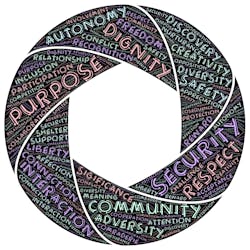Demystifying Next Generation Fiber Workforce Development
Four Strategies to Attract, Train and Maintain New Talent
With telecommunications industry-wide labor shortages making headlines and jeopardizing ambitious nationwide broadband development goals, the topic of workforce development has become center stage in telecommunications-oriented discussions and mainstream media. Many organizations that had de-emphasized fiber training years ago are now dusting off and rebooting their programs, while others are racing to come up with new options to address the gap.
However, many seasoned professionals and instructors challenge the idea of using traditional training approaches for solving the gap, especially when it's becoming clear that the gap is not due to a lack of available training programs, but rather a lack of general interest among new generations in pursuing telecom trade jobs. Solving this might require new approaches for making industry jobs more attractive to younger candidates, as well as innovative workforce development and training strategies to cater to their expectations.
In this article, we propose four strategies to modernize fiber training and cater to a new generation that is ready to meet the immediate network deployment needs today and capable of maintaining the networks of tomorrow—supporting everything from learning, working, gaming, socialization, governing, and even national defense, as well as so many other systems of which we have become so dependent in our modern way of life.
Strategy 1. Don’t Make it Rocket Science
Demystify the knowledge and performance requirements for your audience. Focus on the importance of good workmanship and why fiber work requires attention to detail and dexterity. Countless training programs are designed and delivered with the same approaches, methods, and techniques used 20 years ago, which may not be as effective for digital natives working with products and materials that require a different skill set. With many plug-and-play solutions widely available, where products are ready for installation with minimal manipulation, training requirements have also evolved.
Perhaps placing more focus on things like quality assurance, digitalization or software use, reporting, and learning dexterity could have a greater impact on installations than bringing people to classrooms to go over technical basics. After all, a lot of the technical work is now intimately designed to be performed and managed with NextGen digital tools that include traditional technical activities like cleaver maintenance, to connector inspection, automated fiber testing, and reporting, not to mention AI-mediated end-to-end workflow management and assistance for technicians. Truth is, it is also just as important to upload and maintain reliable field data in network management systems than it is to plug a connector into the network access terminal, for managing, maintaining, and more importantly, expediting turn-ups and delivering good customer service.
Demystifying and making knowledge accessible instead of making it more expensive and harder to acquire, can facilitate the introduction of knowledge and skills to newcomers. If looking for easily accessible and free technical fiber training, learners can take advantage of “Fiber U” by The Fiber Optic Association (FOA), which has been around since 1995. For expert-led, skills-building oriented training programs with coaching and mentoring, KoD Learning’s “FiberWizards Essentials” flagship program offers flexible options that blend technical and NextGen interpersonal management skills for holistic workforce development.
Strategy 2. Connect People with Purpose
Employers that fail to identify and meet new employee demands are not only missing out but also putting their businesses at risk by not meeting their demands for autonomy and flexibility (McKinsey & Co., 2021). Though for some may see fiber jobs as only about installing cables, connectors, and serving antsy customers, we must focus on why telecom industry jobs are meaningful and critical for sustaining and furthering our modern way of life. Our industry offers people access to education, jobs, healthcare, and connection to loved ones, as well as to critical services that we need access to for day-to-day living.
Interpersonal abilities are just as important as technical proficiency for organizations that want to retain talent and outperform their competition. Therefore, digital natives must also learn the skills and dynamics required to work together as a team. Technical proficiency will allow young workers to continue to grow their competencies. However, the future of work will continue to be team centric. Therefore, improving young professionals abilities to communicate with intent, actively listen, collaborate, co-create, and provide mutual support are vital in today’s world of work. Developing these abilities encourages employees to influence and support each other, which are behaviors you want in leaders.
Strategy 3. Foster Lifelong Learning
Don't only focus on standards-centered training and memorization. There are too many standards to remember, and they are constantly changing. Instead, encourage excellence, teach how to find credible sources, research skills, and promote lifelong learning!
Developing a culture where learning is as important as the results you achieve will enable your employees to strive for mastery instead of merely performing to a standard. As time goes on, standards change, the need for different abilities evolve, and a team that prioritizes a growth mindset will have the advantage. Offering and promoting learning through a variety of forms will enable your team to have access to content that is relevant and timely. Cultivating the environment where learning is happening all around will allow your team to ask better questions, share information, and increase cohesion through learning from each other.
Learning should be interesting, intuitive, personalized, and mobile. Modern EdTech (Educational Technology) enables taking the classroom experience to the learner’s place of work and empowers them to learn and apply on-the-go or at their convenience. Leveraging EdTech also lowers spatial limitations from traditional classroom delivery, allowing instructors to be more creative, teaching from where they are, and even providing more opportunities for content creation from the instructor’s place of practice.
Though EdTech has been proven to be an enabler for learning experience enhancement, the method can fall short because many traditional technical instructors are not fluid at using modern EdTech to share their expertise virtually. For technical instructors to be effective in the online space, they must have experience that comes through online teaching training and experience. That will allow them to be fluid in a virtual environment just as they are in face-to-face settings. According to Wieland and Kiollias (2020), passion and confidence also need to translate from the in-person classroom to the virtual learning space for the experience to be comparable.
Strategy 4. Approach Training with a Long-Term View
Go beyond the week-long cramming session. Make training ongoing, relevant, contextualized, and personalized! Workforce development should be viewed as a continuous cycle that occurs over time. Training events should not be one and done. Knowledge is acquired through training but is captured and improved through application. Conducting experiential learning and having continuous access to technical and interpersonal training will allow the cycle of learning and application to be continuous. Learn, apply, assess, repeat. This is known as the learning curve.
Unfortunately, there is also a forgetting curve, which describes the phenomenon of knowledge becoming useless if not applied within days of acquisition. One strategy for avoiding the forgetting curve is to design training that takes place over time and on-the-job, so learners can apply new information and knowledge immediately to their work context.
Instead of solving for technical labor gaps, let's develop the next generation of leaders who share a passion for continuous learning. Let’s encourage them to learn from a variety of methods including traditional classrooms to hands-on to EdTech. Let’s approach training as an ongoing and never-ending endeavor, not a finite event ending when learners pass a test at the end of a class. Let’s commit to ensuring training programs allow for knowledge assimilation, application, and retention so that can translate into work performance gains and quality.
The four strategies we’ve shared are just a few of the ways we can innovate the telecommunications industry space to make it welcoming and friendlier to a digitally native generation. While it demands a more human-centric approach, these strategies will help us build the next generation telecommunications and fiber optics workforce.
REFERENCES AND NOTES- Wieland, N., & Kollias, L. Online Learning Before, During, and After COVID-19: Observations Over 20 Years, https://pdfs.semanticscholar.org/67d6/cb290e155260a59774f032d8ff00ae21220b.pdf
- De Smet, A., Dowling, B., Mugayar-Baldocchi, M., & Schaninger, B. (2021). ‘Great Attrition ’or ‘Great Attraction’? The choice is yours. The McKinsey Quarterly, https://www.proquest.com/openview/d5d8bac592a6b5fbbd46ef0d6452378f/1?pq-origsite=gscholar&cbl=30375
About the Author
Jerry Morla
Founder of FiberWizards and KoD Learning by Knowledge on Demand, LLC
Jerry Morla is the founder of FiberWizards and KoD Learning by Knowledge on Demand, LLC. With over 25 years in telecommunications, he has led workforce development and training programs for top industry companies globally, has served as a faculty member in higher-ed, and is a board member and Master Instructor for The Fiber Optic Association (FOA). He holds an MBA, an MS in Leadership, a Graduate Certificate in Educational Technology and Online Instruction, and is a certified PMP.
For more information, email [email protected] or visit www.knowledgeondemand.com and www.fiberwizards.com. You can also follow him on LinkedIn: https://www.linkedin.com/in/jerrymorla/. Follow FiberWizards on Twitter @fiberwizards, LinkedIn: https://www.linkedin.com/company/fiberwizards/, and https://www.facebook.com/FiberWizards/.
Dr. William Ramey
Practitioner at Shared Leadership, LLC and Consultant at KoD Learning
Dr. William Ramey, with 20 years of leadership experience in the U.S. Army, Fortune 100 companies, and the Government Sector, brings expertise as a practitioner at Shared Leadership, LLC, consultant at KoD Learning, and higher-ed faculty member. His research focuses on leadership behaviors and team dynamics, and he integrates the latest science in organizational behavior, leadership, and team dynamics to deliver evidence-based solutions. He holds a Doctorate and Master of Business Administration and is a certified LEGO® Serious Play® Facilitator.
For more information, email [email protected] or visit www.empowerthepack.com and www.knowledgeondemand.com. You can also follow him on LinkedIn: https://www.linkedin.com/in/drwilliamramey/.



